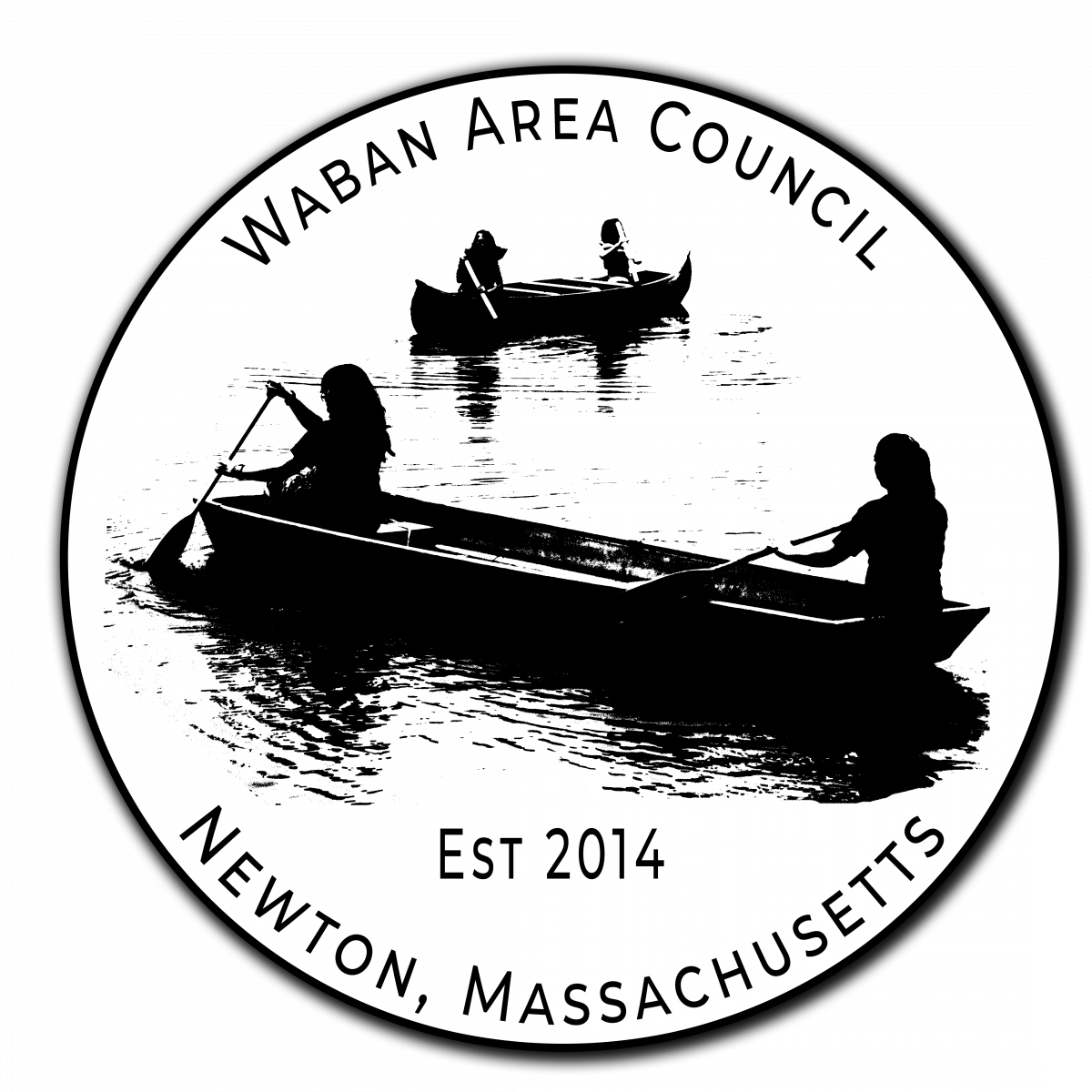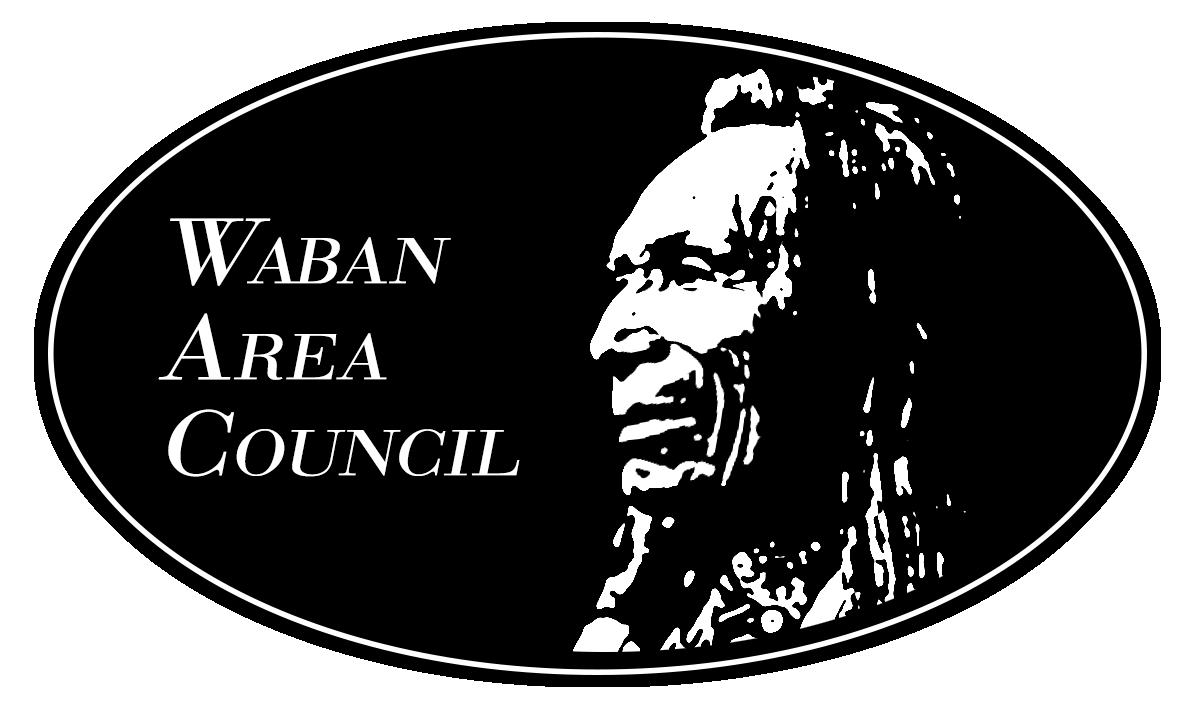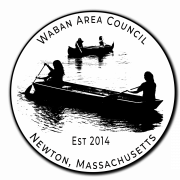Waban Area Council Logo
 rom a number of experts including Drew Lopenzina who has published extensively reserched works on Waban and Elliot. In particular his book Red Ink: Native Americans Picking Up the Pen in the Colonial Period meticuloiusly explores the colonial period of Massachusetts. For our new logo, we settled upon an item which was of great importance to native americans, crossed time into present day, and still plays an important part of the Quinobequin and the Charles River.
rom a number of experts including Drew Lopenzina who has published extensively reserched works on Waban and Elliot. In particular his book Red Ink: Native Americans Picking Up the Pen in the Colonial Period meticuloiusly explores the colonial period of Massachusetts. For our new logo, we settled upon an item which was of great importance to native americans, crossed time into present day, and still plays an important part of the Quinobequin and the Charles River. 
Our original logo, which was a placeholder, had been used for many years but was not without controversy. Our position was that we would replace the logo when we found a more appropriate image yet still connected to the native American history of Waban. Research was underway and discussion for graphic options continued. Most people don't know the story of Waban beyond the fact that this area was a favored hunting ground. Chris Pitts created the logo, his reasoning for using a native american are clear in the exchange below. For a history of the Waban and the Praying Indians of Natick and Ponkapoag, click on this link. For the most comphrehensive history, please read Drew Lopenzina's book linked above. His book is available at the Newton Free library and his dissertation which is the basis of the book is available on the web here.
From: <prayingindians@natickprayingindians.com>
Date: Wed, Nov 26, 2014 at 5:17 PM
Subject: RE: Waban logo
To: Christopher Pitts <cbpitts@gmail.com>
-------- Original Message --------
Subject: Waban logo
From: Christopher Pitts <cbpitts@gmail.com>
Date: Tue, November 18, 2014 8:54 am
To: prayingindians@natickprayingindians.com
Cc: Maureen Reilly Meagher <mreillymeagher@gmail.com>
Hello,I live in Waban, a village of Newton, Massachusetts. I am a member of the newly formed Waban Area Council which came together about 18 months ago. I'd like your help with the Waban Area Council's current logo -- namely, is it racist, and should it therefore be changed?A little historical background--------------------------------------------The town of Newton MA (pop 85,000) is made up of 13 villages: Auburndale, Chestnut Hill, Newton Centre, Newton Corner, Newton Highlands, Lower Falls, Upper Falls, Newtonville, Oak Hill, Thompsonville, West Newton, Nonantum, and Waban. Only the last two have reference to Native Americans who once populated the area.Newton was settled in 1630 as part of "the newe towne", which was renamed Cambridge in 1638. Roxbury minister John Eliot convinced the Native American people of Nonantum, a sub-tribe of the Massachusetts led by a sachem named Waban, to relocate to Natick in 1651, fearing that they would be exploited by colonists.Waban, of the Nipmuc group, was born about 1604 at Musketaquid, near the present town of Concord. His conversion to Christianity came on October 28, 1646 (Julian calendar), when the missionary Reverend John Eliot preached his first sermon toNative Americans in their own language in Waban's large wigwam in Nonantum, Massachusetts, and Waban and many of his tribe were converted.
Waban maintained close and friendly relations with the white settlers of Massachusetts and, in April 1675, reported to an English magistrate that trouble was brewing amongst the Wampanoags. Within two months, Waban's predictions came to pass when a Wampanoag named Metacomet, known as "King Philip," led his nation in the initially successful King Philip's War. Metacomet's subsequent death in August 1676 signaled the end of the brief war, and the rebellion soon collapsed due to a lack of leadership. Nevertheless, Waban, falsely accused of being a conspirator, was imprisoned in October 1675. After a brief period of captivity, Waban was released in the spring of 1676 and returned to his settlement of Natick, Massachusetts.
Waban is often considered to be tribal chief of the Nonantum tribe, but this is a misnomer. According to John Eliot, Waban was actually "the chief minister of justice", not a "sachem", but the title "chief minister of justice" is not used by Native Americans. In reality, Waban did not hold an authoritative, political position within his own nation. The exact date of Waban's death is not known, with it being reported as early as late 1676 or early 1677[5] and as late as ca. 1685. Note: This is from a wikipedia entry that claims Waban was a Nipmuc and here is a publication which suggests otherwise.
The Nipmuc or Nipmuck people are descendants of the indigenous Algonquian peoples of Nippenet, 'the freshwater pond place', which corresponds to central Massachusetts and immediately adjacent portions of Connecticut and Rhode Island. The tribe was first encountered by Europeans in 1630, when John Acquittamaug arrived with maize to sell to the starving colonists of Boston, Massachusetts.The logo ----------------------------------------------------------------Just so there is no confusion, the only logo I am concerned about is the Waban Area Council www.wabanareacouncil.com and I also happen to be the guy who created the logo. The last thing I had in mind was to be offensive. I thought it was a way of acknowledging the Native American heritage of the area - lest it all be whitewashed away. I guess it all comes down to the image I used -Three Eagles Nez Perce photographed by Edward Curtis - and if that is inappropriate. I searched extensively for an image that was not adorned with weapons or headdresses fearing those would not be appropriate and confused with the Windsor Club's logo.Waban already has two instances of Native Americans appearing on logos, the village entrance sign, and the Windsor Club (see attached) Newton's logo also includes Native Americans (see attached) conversing with John Elliot.We've been using the logo for years, and just yesterday got feedback from a neighbor that he believes it to be racist -- his point is that this is especially true since we did not use a picture of Waban himself. The feedback is troubling, and thus my reach-out. The intent, as stated, is to acknowledge the Native American heritage, and of course there are no pictures of Waban himself to draw from. I'd be interested to hear if it is in any ways troubling, if so, I will change it.
